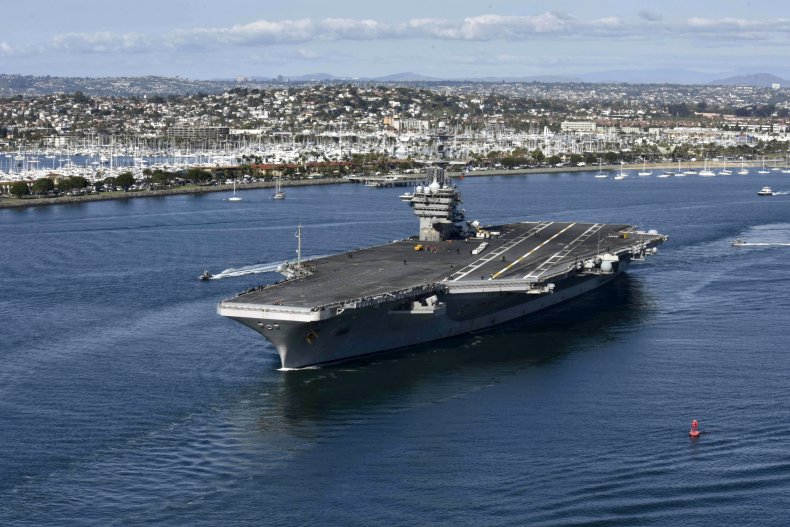U.S. Military Near China a Sign of Joe Biden's 'Insecurity'—Chinese Analyst
The frequent appearances of American military assets in the South China Sea are signs of the Biden administration's "insecurities" and signal its intention to stop the Chinese military from making any "big moves," a Beijing-based maritime specialist has written.
In his article for the bimonthly Chinese journal World Affairs, Peking University professor Hu Bo warned policymakers in Beijing that the Chinese military may soon routinely face two U.S. Navy aircraft carrier strike groups on its doorstep.
"The United States has adjusted the deployment patterns of its aircraft carriers because it wants to intensify combat exercises directed at China in the South China Sea and the surrounding areas," Hu said in the March 1 issue. "It plans to have the capability of winning a conflict in an extreme contingency."
The posting of naval assets to the region also helps the U.S. strengthen its deterrence against China and prevents the People's Liberation Army from making any "big moves," said Hu, who is the director of the Center for Maritime Strategy Studies, a Peking University think tank.
The maritime security analyst said recent U.S. military movements in the area were "likely linked to the insecurities of the new administration," citing the Theodore Roosevelt Carrier Strike Group's two deployments to the South China Sea in the space of three weeks in January and February, as well as the dual-carrier operations conducted by USS Theodore Roosevelt and USS Nimitz last month.
"American aircraft carriers entering the South China Sea no longer make headlines," he wrote. "It's not that American carriers aren't allowed in the South China Sea. China opposes the escalating show of force and the patent targeting of China."
Hu also heads the Beijing-based South China Sea Strategic Situation Probing Initiative (SCSPI), a think tank that details movements around China by the U.S. military and that of other nations.
An SCSPI report on Tuesday said U.S. reconnaissance aircraft flew 75 sorties in the South China Sea in February. The "uptick," said the think tank, coincided with the carrier strike group exercises and other U.S. warship missions.
75 US surveillance aircraft operated over the #SouthChinaSea in February, showing an uptick from the previous months.
— SCS Probing Initiative (@SCS_PI) March 2, 2021
Most of the missions were carried out by the Navy, whose P-8A flew on a daily basis. The operations of MQ-4C #UAV and CL-604 were also eye-catching. pic.twitter.com/GDwPfK9tcc
The regularity of U.S. naval missions was decreasing but the number of combat readiness deployments were going up, Hu said in his analysis for World Affairs.
American warships now routinely appear in the Philippine Sea as they practice how to counter China's anti-access and area denial to intervene in contingencies in "hotspots" like the South China Sea and Taiwan Strait, he wrote.
America's 11 aircraft carriers, he notes, are key to the country's ability to project power, which is so far unmatched by any other nation. However, he said Washington would be "anxious" about overworking its carriers in so-called "double-pump" deployments—two missions within the same 36-month readiness cycle.
Citing analysis done by United States Naval Institute last November, Hu said U.S. aircraft carriers spent 855 days at sea between January and October 31, 2020. That figure was 258 days more than the entirety of 2019.
If the current trend continues, Hu predicts, U.S. aircraft carrier deployments to the South China Sea will "substantially increase and potentially reach tens of times a year."
"China and its military may need to prepare to routinely face up to two American aircraft carrier strike groups in the Western Pacific," Hu wrote, calling the U.S. naval base in Guam a "strategic fulcrum" for American power projection.
Beijing will also need a plan to counter the frequent warship deployments to the South China Sea, he concluded.
On Wednesday, retired Chinese naval officer and military commentator Song Xiaojun told the CCTV program Defense Review that the U.S. was sending its ships to the South China Sea and Taiwan Strait in order to "amplifying the 'China threat' [theory]" and "win over allies."
As President Joe Biden prepares for a "long-term strategic war" with Beijing, he will need several months to decide which of China's threats he wants to prioritize, Song said on the show, which is broadcast to the Chinese public every weekday evening.
In the hours after the program aired, Secretary of State Antony Blinken gave his first major address about U.S. foreign policy under Biden, in which he described China as America's "biggest geopolitical test of the 21st century."
The White House has recently published its 23-page Interim National Security Strategic Guidance, which referred to China as the "only competitor potentially capable of combining its economic, diplomatic, military, and technological power to mount a sustained challenge to a stable and open international system."


